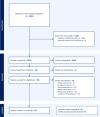At-home specimen self-collection as an additional testing strategy for chlamydia and gonorrhoea: a systematic literature review and meta-analysis
- PMID: 39191483
- PMCID: PMC11404247
- DOI: 10.1136/bmjgh-2024-015349
At-home specimen self-collection as an additional testing strategy for chlamydia and gonorrhoea: a systematic literature review and meta-analysis
Abstract
Introduction: Chlamydia trachomatis (Ct) and Neisseria gonorrhoeae (Ng) infections are often asymptomatic; screening increases early detection and prevents disease, sequelae and further spread. To increase Ct and Ng testing, several countries have implemented specimen self-collection outside a clinical setting. While specimen self-collection at home is highly acceptable to patients and as accurate as specimens collected by healthcare providers, this strategy is new or not being used in some countries. To understand how offering at home specimen self-collection will affect testing uptake, test results, diagnosis and linkage to care, when compared with collection in clinical settings, we conducted a systematic literature review and meta-analysis of peer-reviewed studies.
Methods: We searched Medline, Embase, Global Health, Cochrane Library, CINAHL (EBSCOHost), Scopus and Clinical Trials. Studies were included if they directly compared specimens self-collected at home or in other non-clinical settings to specimen collection at a healthcare facility (self or clinician) for Ct and/or Ng testing and evaluated the following outcomes: uptake in testing, linkage to care, and concordance (agreement) between the two settings for the same individuals. Risk of bias (RoB) was assessed using Cochrane Risk of Bias (RoB2) tool for randomised control trials (RCTs).
Results: 19 studies, from 1998 to 2024, comprising 15 RCTs with a total of 62 369 participants and four concordance studies with 906 participants were included. Uptake of Ct or Ng testing was 2.61 times higher at home compared with clinical settings. There was a high concordance between specimens collected at home and in clinical settings, and linkage to care was not significantly different between the two settings (prevalence ratio 0.96 (95% CI 0.91-1.01)).
Conclusion: Our meta-analysis and systematic literature review show that offering self-collection of specimens at home or in other non-clinical settings could be used as an additional strategy to increase sexually transmitted infection testing in countries that have not yet widely adopted this collection method.
Keywords: Diagnostics and tools; Infections, diseases, disorders, injuries; Public Health; Systematic review.
© Author(s) (or their employer(s)) 2024. Re-use permitted under CC BY. Published by BMJ.
Conflict of interest statement
Competing interests: None declared.
Figures



References
-
- World Health Organization WHO sexually transmitted infections (stis): key facts. 2020
-
- Public Health Agency of Canada Chlamydia, gonorrhea and infectious syphilis in canada 2020 (infographic) 2023
-
- European Centre for Disease Prevention and Control Chlamydia annual epidemiological report for 2022 annual epidemiological report for 2022. 2024
-
- European Centre for Disease Prevention and Control . Stockholm: ECDC; 2024. Gonorrhoea ECDC annual epidemiological report for 2022.
-
- King J, McManus H, Gray R, et al. HIV, viral hepatitis and sexually transmissible infections in australia annual surveillance report 2021. 2022
Publication types
MeSH terms
LinkOut - more resources
Full Text Sources
Medical
